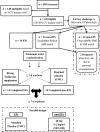Acute benefits of the microbial-derived isoflavone metabolite equol on arterial stiffness in men prospectively recruited according to equol producer phenotype: a double-blind randomized controlled trial
- PMID: 26843154
- PMCID: PMC4763500
- DOI: 10.3945/ajcn.115.125690
Acute benefits of the microbial-derived isoflavone metabolite equol on arterial stiffness in men prospectively recruited according to equol producer phenotype: a double-blind randomized controlled trial
Abstract
Background: There is much speculation with regard to the potential cardioprotective benefits of equol, a microbial-derived metabolite of the isoflavone daidzein, which is produced in the large intestine after soy intake in 30% of Western populations. Although cross-sectional and retrospective data support favorable associations between the equol producer (EP) phenotype and cardiometabolic health, few studies have prospectively recruited EPs to confirm this association.
Objective: The aim was to determine whether the acute vascular benefits of isoflavones differ according to EP phenotype and subsequently investigate the effect of providing commercially produced S-(-)equol to non-EPs.
Design: We prospectively recruited male EPs and non-EPs (n = 14/group) at moderate cardiovascular risk into a double-blind, placebo-controlled crossover study to examine the acute effects of soy isoflavones (80-mg aglycone equivalents) on arterial stiffness [carotid-femoral pulse-wave velocity (cfPWV)], blood pressure, endothelial function (measured by using the EndoPAT 2000; Itamar Medical), and nitric oxide at baseline (0 h) and 6 and 24 h after intake. In a separate assessment, non-EPs consumed 40 mg S-(-)equol with identical vascular measurements performed 2 h after intake.
Results: After soy intake, cfPWV significantly improved in EPs at 24 h (cfPWV change from 0 h: isoflavone, -0.2 ± 0.2 m/s; placebo, 0.6 ± 0.2 m/s; P < 0.01), which was significantly associated with plasma equol concentrations (R = -0.36, P = 0.01). No vascular effects were observed in EPs at 6 h or in non-EPs at any time point. Similarly, no benefit of commercially produced S-(-)equol was observed in non-EPs despite mean plasma equol concentrations reaching 3.2 μmol/L.
Conclusions: Acute soy intake improved cfPWV in EPs, equating to an 11-12% reduced risk of cardiovascular disease if sustained. However, a single dose of commercially produced equol had no cardiovascular benefits in non-EPs. These data suggest that the EP phenotype is critical in unlocking the vascular benefits of equol in men, and long-term trials should focus on confirming the implications of EP phenotype on cardiovascular health. This trial was registered at clinicaltrials.gov as NCT01530893.
Keywords: CVD risk; arterial stiffness; equol producer phenotype; flavonoids; isoflavone; vascular function.
Figures


Similar articles
-
Research protocol: effect of natural S-equol on blood pressure and vascular function--a six-month randomized controlled trial among equol non-producers of postmenopausal women with prehypertension or untreated stage 1 hypertension.BMC Complement Altern Med. 2016 Mar 1;16:89. doi: 10.1186/s12906-016-1065-5. BMC Complement Altern Med. 2016. PMID: 26928904 Free PMC article. Clinical Trial.
-
Soy-isoflavone-enriched foods and inflammatory biomarkers of cardiovascular disease risk in postmenopausal women: interactions with genotype and equol production.Am J Clin Nutr. 2005 Dec;82(6):1260-8; quiz 1365-6. doi: 10.1093/ajcn/82.6.1260. Am J Clin Nutr. 2005. PMID: 16332659 Clinical Trial.
-
Effect of whole soy and purified daidzein on ambulatory blood pressure and endothelial function--a 6-month double-blind, randomized controlled trial among Chinese postmenopausal women with prehypertension.Eur J Clin Nutr. 2015 Oct;69(10):1161-8. doi: 10.1038/ejcn.2015.24. Epub 2015 Mar 18. Eur J Clin Nutr. 2015. PMID: 25782428 Clinical Trial.
-
Potential Protective Mechanisms of S-equol, a Metabolite of Soy Isoflavone by the Gut Microbiome, on Cognitive Decline and Dementia.Int J Mol Sci. 2022 Oct 7;23(19):11921. doi: 10.3390/ijms231911921. Int J Mol Sci. 2022. PMID: 36233223 Free PMC article. Review.
-
Equol Decreases Hot Flashes in Postmenopausal Women: A Systematic Review and Meta-Analysis of Randomized Clinical Trials.J Med Food. 2019 Feb;22(2):127-139. doi: 10.1089/jmf.2018.4265. Epub 2018 Dec 28. J Med Food. 2019. PMID: 30592686
Cited by
-
(Poly)phenolic compounds and gut microbiome: new opportunities for personalized nutrition.Microbiome Res Rep. 2022 Apr 27;1(3):16. doi: 10.20517/mrr.2022.06. eCollection 2022. Microbiome Res Rep. 2022. PMID: 38046361 Free PMC article.
-
Meeting report: plant-rich dietary patterns and health.Proc Nutr Soc. 2022 Dec;81(4):288-305. doi: 10.1017/S002966512200266X. Epub 2022 Aug 23. Proc Nutr Soc. 2022. PMID: 35996940 Free PMC article. Review.
-
Dietary Patterns Affect the Gut Microbiome-The Link to Risk of Cardiometabolic Diseases.J Nutr. 2018 Sep 1;148(9):1402-1407. doi: 10.1093/jn/nxy141. J Nutr. 2018. PMID: 30184227 Free PMC article. Review.
-
Inverse association between soy food consumption, especially fermented soy products intake and soy isoflavone, and arterial stiffness in Japanese men.Sci Rep. 2018 Jun 25;8(1):9667. doi: 10.1038/s41598-018-28038-0. Sci Rep. 2018. PMID: 29941884 Free PMC article.
-
Evaluating serum S-Equol, indoxyl sulfate, and TMAO in predicting urinary stones in children: a prospective study.Urolithiasis. 2025 Apr 5;53(1):68. doi: 10.1007/s00240-025-01737-w. Urolithiasis. 2025. PMID: 40186630 Free PMC article.
References
-
- Setchell KD, Cole SJ. Method of defining equol-producer status and its frequency among vegetarians. J Nutr 2006;136(8):2188–93. - PubMed
-
- Tormala R, Appt S, Clarkson TB, Groop PH, Ronnback M, Ylikorkala O, Mikkola TS. Equol production capability is associated with favorable vascular function in postmenopausal women using tibolone; no effect with soy supplementation. Atherosclerosis 2008;198(1):174–8. - PubMed
-
- Guo K, Zhang B, Chen C, Uchiyama S, Ueno T, Chen Y, Su Y. Daidzein-metabolising phenotypes in relation to serum lipids and uric acid in adults in Guangzhou, China. Br J Nutr 2010;104:118–24. - PubMed
Publication types
MeSH terms
Substances
Associated data
Grants and funding
LinkOut - more resources
Full Text Sources
Other Literature Sources
Medical

